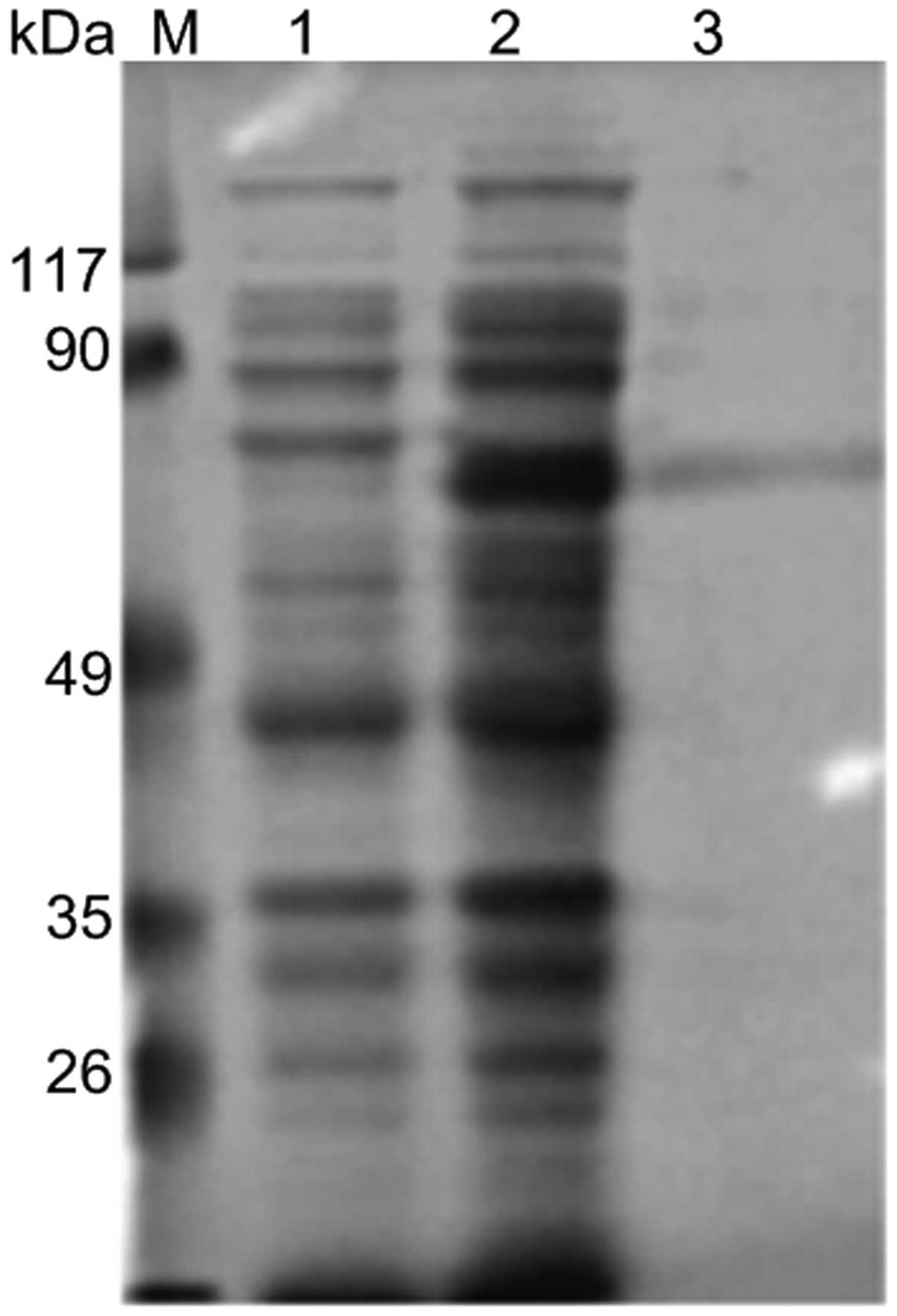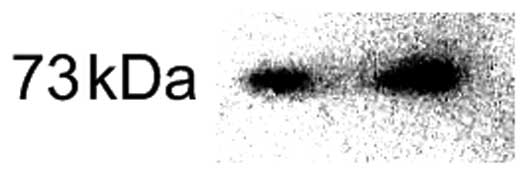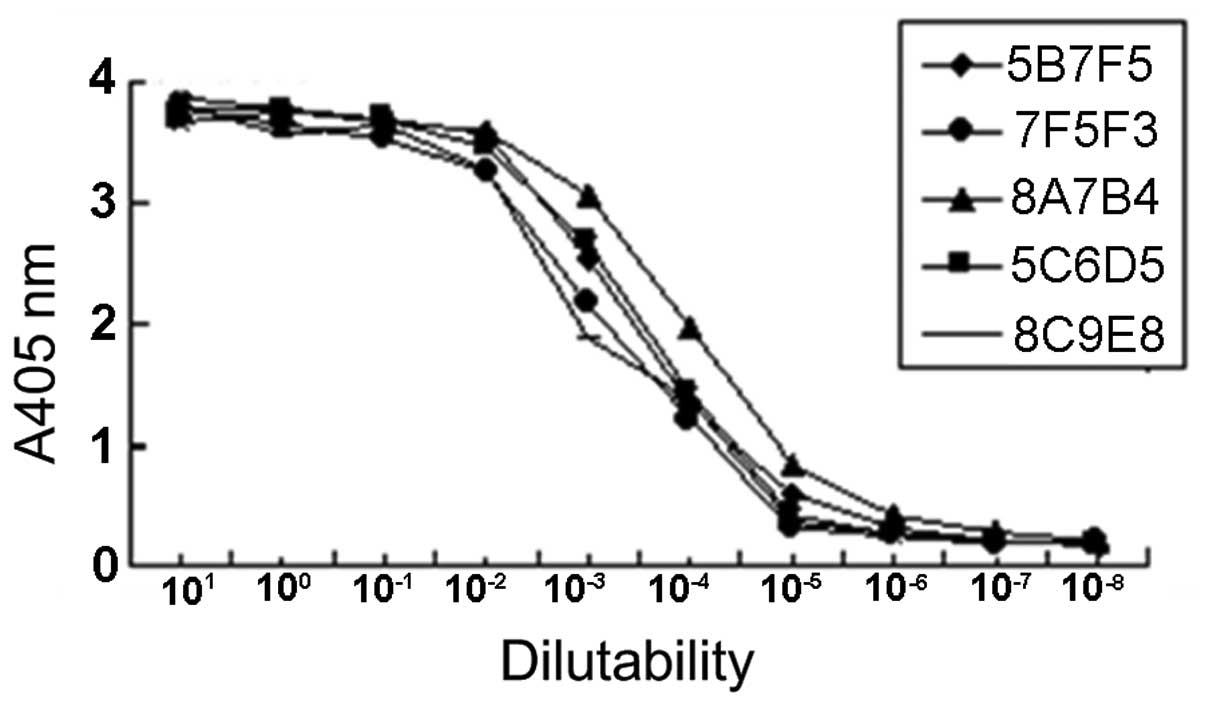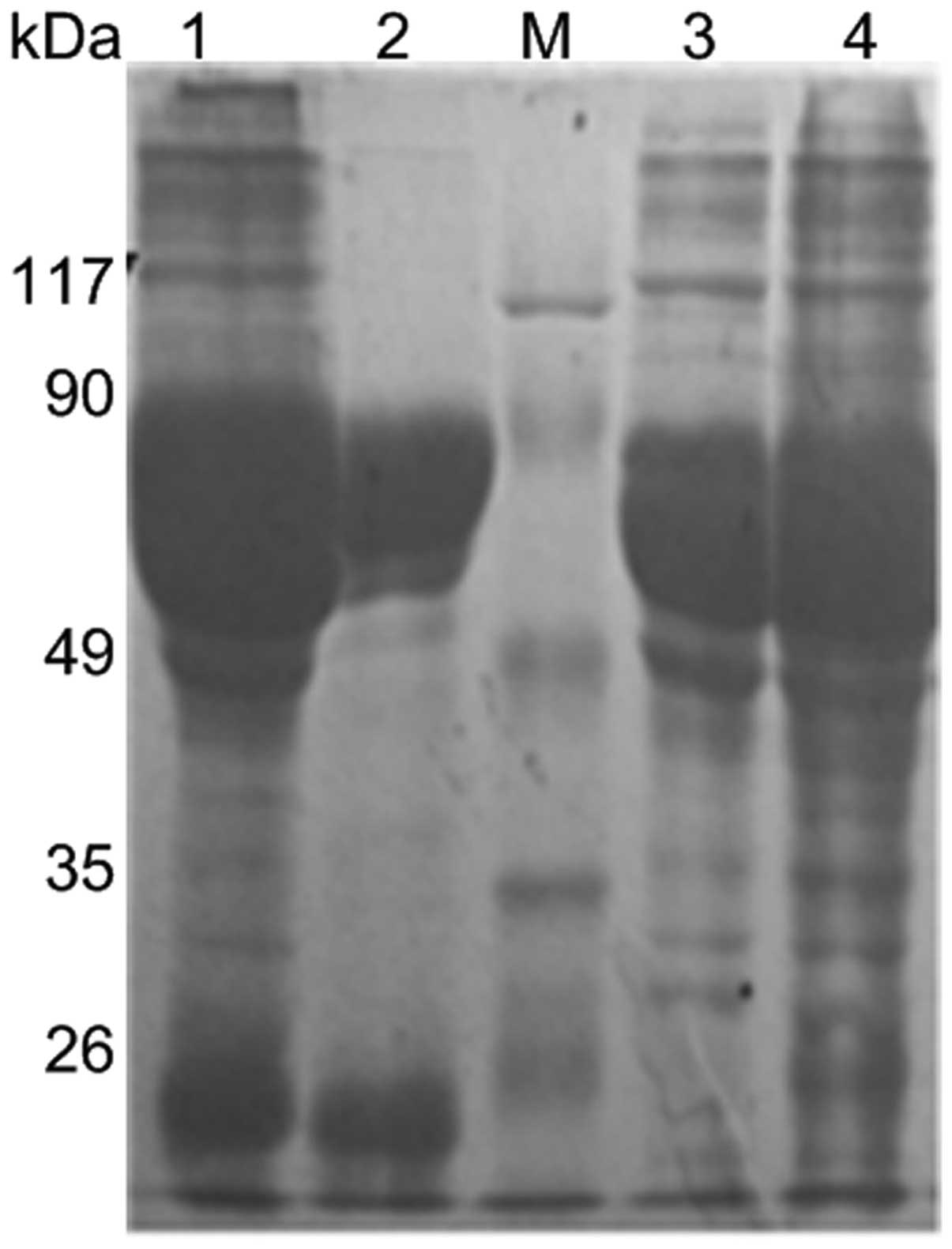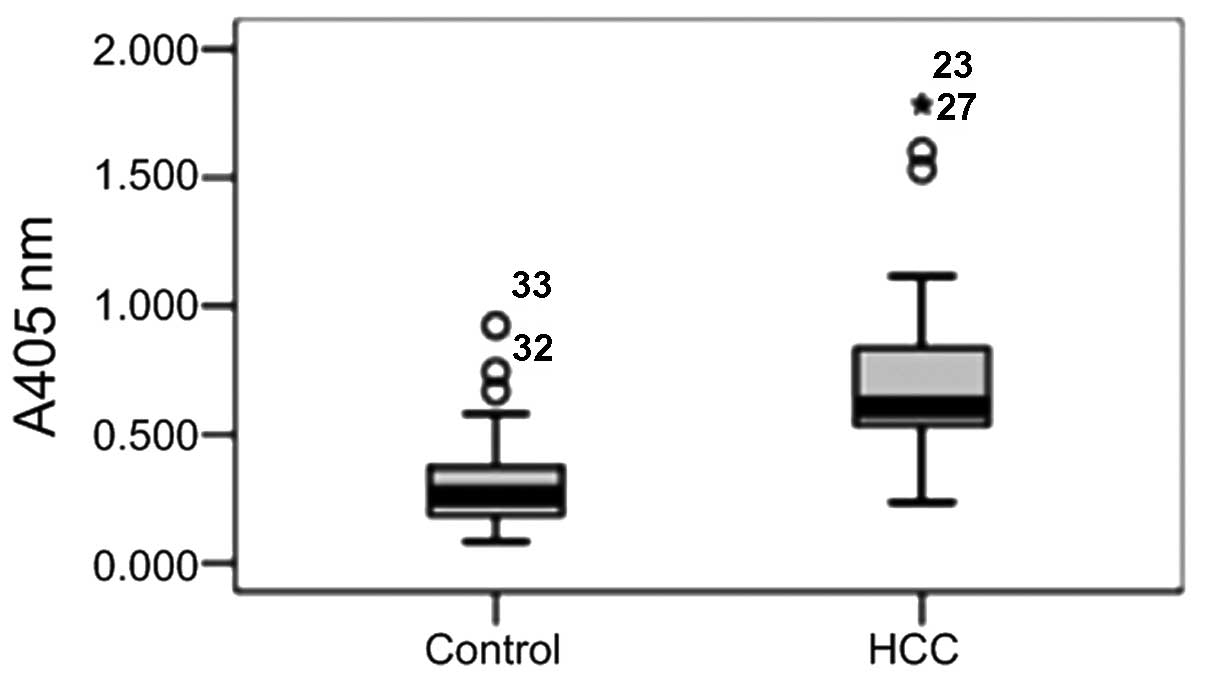Monoclonal antibody preparation of Golgi phosphoprotein 2 and preliminary application in the early diagnosis of hepatocellular carcinoma
- Authors:
- Published online on: May 31, 2013 https://doi.org/10.3892/mmr.2013.1503
- Pages: 517-522
Abstract
Introduction
Hepatocellular carcinoma (HCC) is one of the most common malignant tumors with high malignancy and mortality due to lack of early diagnosis and its resistance to conventional chemotherapy (1). HCC affects approximately one million people every year worldwide, with the incidence equal to the mortality. In 2008, HCC was listed as the third most common cause of cancer-related mortality (2). Thus, early diagnosis is crucial in order to increase the survival rate for patients (3). To date, alpha-fetoprotein (AFP) together with imaging and pathology detection are commonly used in early clinical diagnosis of liver cancer. However, the specificity and sensitivity of AFP for liver cancer screening are not satisfactory. With the development of molecular biology, a number of new types of tumor markers have been discovered.
Golgi phosphoprotein 2 (Golph2) is a type II Golgi-specific membrane protein that is predominantly expressed in the epithelial cells of a number of human tissues (4). In normal human liver, Golph2 is only expressed in biliary epithelial cells and is almost undetected in liver cells. However, increased expression of Golph2 has been reported to be correlated with numerous viral or non-viral infectious liver diseases (5). It was first identified in a search for upregulated hepatic genes in acute giant-cell hepatitis (4)q and then in patients with acute and chronic hepatitis (6). Studies revealed that Golph2 was overexpressed in the serum of HCC patients (7,8). In China, Mao et al first observed that the level of Golph2 in the serum of patients with HCC infected by hepatitis B virus (HBV) was significantly higher than HBV carriers, patients without hepatic diseases and healthy adults (9). In addition, other studies reported that the sensitivity of diagnosis of HCC by Golph2 (76%) was higher than AFP (70%), indicating that Golph2 may be a novel and effective serum biomarker for the diagnosis of HCC (10).
In the present study, we established hybridoma cell lines that stably secrete anti-Golph2 monoclonal antibody (mAb). Using selected, purified and enzyme-labeled anti-Golph2 mAb, we detected the level of antigen in HCC and healthy samples by double-antibody sandwich enzyme-linked immunosorbent assay (s-ELISA) and expect this method to be used in diagnostics and therapeutics in the future.
Materials and methods
Subjects
The study protocol was approved by the Central South University’s Institutional Review Board, Changsha, Hunan, China and written informed consent was obtained from each subject. Demographic and clinical information was obtained, and a blood sample was collected from each subject. All the subjects were recruited from the clinics at Xiangya Second Hospital, Changsha, Hunan between March 2012 and November 2012. The diagnosis of HCC was made based on guidelines from the Chinese Society of Hepatology, the Chinese Society of Infectious Diseases and the Chinese Medical Association (11–13). A 4 ml blood sample obtained from each subject prior to the initiation of HCC treatment was centrifuged and the serum aliquoted and stored at −80˚C until testing (n=30; age, 54.30±10.14 years; HBV-positive). Control subjects were enrolled from staff with no liver disease or risk factors for viral hepatitis, and who were in normal physiological condition [n=30; age, 49.87±9.23 years; normal control (NC)]. Balb/c mice were maintained according to institutional animal care and use committee (IACUC-BIDMC) protocols.
Expression, purification and identification of recombinant protein
The recombinant plasmid pET21a(+)-TRX-Golph2, which was constructed in the laboratory, was transformed into Escherichia coli Rosetta (ATCC, Manassas, VA, USA) and optimal expression of recombinant proteins was achieved through controlling the concentration of isopropyl-β-D-thiogalactopyranoside (IPTG) and growth conditions. After induction, bacteria were harvested and centrifuged at 4˚C, 4,449 × g for 10 min, and the pellet was resuspended in 50 mmol/l sodium phosphate with 0.3 mol/l NaCl (pH 8.0). The resuspended cells were then lysed by sonication and centrifuged at 4°C, 10,012 × g for 10 min. The expression form of fusion protein TRX-Golph2 was analyzed by sodium dodecyl sulfate-polyacrylamide gel electrophoresis (SDS-PAGE, 12% gel).
The recombinant protein TRX-Golph2 was further purified by immobilized metal affinity chromatography (MagneHis™ Protein Purification System; Promega, Madison, WI, USA) under native conditions. The purified protein was dialyzed in 1X phosphate buffered saline (PBS) at 4°C overnight and condensed to a high concentration.
The concentrated recombinant protein was separated by SDS-PAGE on a 12% polyacrylamide gel and then transferred onto a nitrocellulose membrane (Millipore, Billerica, MA, USA) by electroblotting. Fat-free milk (5%) was used to block the membrane at 37°C for 2 h. The membrane was then incubated with anti-His tag antibody (1:2,000; Santa Cruz Biotechnology, Inc., Santa Cruz, CA, USA) overnight in a 4°C refrigerator. The membrane was then washed with PBS-Tween-20 (PBST) three times and incubated with the horseradish peroxidase (HRP)-conjugated goat anti-mouse secondary antibody (1:1,000, Sigma, St. Louis, MO, USA) in a 37°C shaker for 1 h. After washing three times with PBST, the membrane was visualized with an enhanced chemiluminescence (ECL) system (Pierce Biotechnology, Inc., Rockford, IL, USA).
Immunization of mice
Eight-week-old Balb/c mice were immunized three times with purified TRX-Golph2 fusion protein at days 0, 21 and 42 with 100, 50 and 50 μg, respectively, by peritoneal injection. Complete and incomplete Freund’s adjuvant (1:1, Sigma) were used to emulsify the protein in the first and other immunizations, respectively. Ten days after the third immunization, mice were bled from the caudal vein and the serum titer was detected by indirect ELISA. Three days after the last booster immunization (100 μg), the spleen of the mouse with the highest titer was removed under sterile conditions to prepare a splenic lymphocyte suspension for cell fusion.
Cell culture and fusion
Mouse myeloma cell line SP2/0 was cultured in 10% fetal bovine serum (Hyclone, Tauranga, New Zealand) and RPMI-1640 medium (Gibco-BRL, Grand Island, NY, USA) in a 37°C, 5% CO2 incubator. The feeder cells, obtained from the peritoneal cavity of a normal BALB/c mouse by peritoneal injection of RPMI-1640 medium, were plated in 96-well plates and cultured in a 37°C, 5% CO2 incubator for 1 day prior to fusion. Splenic lymphocytes (1×108) were fused with SP2/0 cells (1×107) in 50% polyethylene glycol 1500 (PEG 1500, Sigma-Aldrich, St. Louis, MO, USA). The hybridoma cells were cultured in 96-well plates containing feeder cells and screened by hypoxanthine-aminopterin-thymidine (HAT; Sigma-Aldrich) and cultured in a 37°C, 5% CO2 incubator. Two weeks later, indirect ELISA using purified TRX-Golph2 protein and HepG2 cells as coating proteins, respectively, was performed to detect the positive clones and then screened clones were recloned by limiting dilution in hypoxanthine-thymidine (HT; Sigma-Aldrich) medium for a further 2 weeks.
Screening of positive clones and cloning
By observing the 96-well plates, we selected a single clone to perform the indirect ELISA using purified TRX-Golph2 protein and HepG2 cells as coating proteins, respectively. The optical density (OD) was read at a wavelength of 405 nm (microplate reader, Tianshi, Beijing, China) and considered positive when the ratio of OD test to OD control was greater than 3 times. The wells that were positive for both purified TRX-Golph2 protein and HepG2 cells were considered as positive wells and then recloned 3–5 times by limiting dilution until their antibody secretion was 100%. Finally, the positive clones in the 96-well plates were transferred to 24-well plates in 10% fetal bovine serum RPMI-1640 medium. The strain of hybridoma cells that secreted specific mAb was established.
Preparation and titer determination of anti-Golph2 mAb
Balb/c mice were injected with incomplete Freund’s adjuvant (0.5 ml) by peritoneal injection. Three days later, the mice were peritoneally injected with 5×106 hybridoma cells diluted by D-Hank’s. Ten days later, ascitic fluid was collected and centrifuged at 278 × g for 5 min to remove the cellular deposition. Anti-Golph2 mAb in supernatant was diluted into different gradients (1:100; 1:200; 1:400; 1:800; 1:1,600; 1:3,200; 1:6,400; 1:12,800; 1:25,600; 1:51,200) and added into 96-well plates coated with TRX-Golph2 antigen, respectively. Indirect ELISA was performed to detect the titer of anti-Golph2 mAb. The OD was read at 405 nm.
Subclass determination and purification of anti-Golph2 mAb
The subclass of anti-Golph2 mAb was determined using the SBA Clonotyping System (SouthernBiotech, Birmingham, AL, USA) according to the manufacturer’s instructions. The anti-Golph2 mAb (3 ml) was added with equivalent precooled ammonium sulfate overnight in a 4°C refrigerator. They were then centrifuged at 4°C, 1,738 × g for 15 min. The supernatant was decanted, solubilized by adding PBS (0.02 M, 3 ml), and then filtered by Sephacryl S-300 HR gel filtration (Pharmacia, USA). PBS containing 0.02% NaN3 was used to wash the column and collected components. The positive components confirmed by indirect ELISA were dialyzed in PBS at 4°C overnight and condensed to a high concentration. The purity was identified by SDS-PAGE (12%).
Determination of the relative mAb affinity
A 96-well immunoplate was coated with the TRX-Golph2 fusion protein (4 μg/ml) at 4°C overnight, and then was blocked with 2% fetal bovine serum at 37°C for 2 h. Serial dilutions of the purified mAb were incubated at 37°C for 2 h. The plate was rinsed and incubated with the HRP-conjugated goat anti-mouse antibody (1:4,000 dilution) at 37°C for 1 h. After washing, TMB (3,3′,5,5′-tetramethylbenzidine) substrate was used for color development. The OD value was measured at 405 nm in order to determine the relative affinity.
Western blot analysis of anti-Golph2 mAb specificity
Total proteins extracted from HepG2 cells were separated by SDS-PAGE on a 12% polyacrylamide gel and then transferred onto a nitrocellulose membrane (Millipore) by electroblotting. Fat-free milk (5%) was used to block the membrane at 37°C for 2 h. The membrane was then incubated with purified anti-Golph2 mAb (1:2,000) overnight in a 4°C refrigerator. The membrane was then washed with PBS-Tween-20 (PBST) three times and incubated with the HRP-conjugated goat anti-mouse secondary antibody (1:1,000) in a 37°C shaker for 1 h. After washing three times with PBST, the membrane was visualized with an ECL system (Pierce Biotechnology, Inc.).
Immunocytochemistry
Appropriate amounts of cells were cultured on microslides overnight. When the cells were adherent, slides were fixed with 4% paraformaldehyde for 15 min. PBST (0.5%) was used to wash the slides three times. Endogenous peroxidase activity was blocked by 3% H2O2/methanol and non-specific binding was blocked with 2% BSA-PBS. Diluted anti-Golph2 mAb (50 μl; 1:50) was added and incubated overnight in a 4°C refrigerator. After three 0.5% PBST washes, the appropriate (1:200) HRP-conjugated goat anti-mouse secondary antibody was added and incubated at room temperature for 1 h. Slides were washed with 0.5% PBST three times. Diaminobenzidine (DAB) was added and allowed to react for 1 min. The reaction was stopped by adding water and hematoxylin was added to counterstain for 2 min. Slides were dehydrated with alcohol and mounted with neutral gummi.
Preparation of enzyme-labeled anti-Golph2 mAb
Modified sodium periodate oxidation was used for labeling anti-Golph2 mAb (8A7B4) with high purity. The result and the optimal working concentration of labeled anti-Golph2 mAb with HRP were analyzed by direct ELISA.
Establishment and optimization of double-antibody s-ELISA
A 96-well immunoplate was coated with purified anti-Golph2 mAb (5C6D5, 20 μg/ml) at 4°C overnight and then blocked with 2% BSA-PBS at 4°C overnight. After washing plates with PBST three times, serum dilutions (1:2, 1:4, 1:8), strong positive (50 ng/ml antigen), weak positive (3 ng/ml antigen) and negative, were incubated at 37°C for 2 h, respectively. The plates were washed three times and enzyme-labeled anti-Golph2 mAb (1:300, 1:400, 1:500, 1:600) was added and the plates were incubated at 37°C for 1 h. The plates were washed again and colored with 100 μl 2,2-Azinobis (3-ethylbenzothiazoline-6-sulfonic acid) diammonium salt (ABTS; Boehringer Mannheim GmbH, Germany) for 25 min at 37°C. The OD was read at a wavelength of 405 nm. A chessboard titration method was designed to examine the optimal working concentration of HRP-labeled mAb and the dilution ratio of serum.
Analysis of serum samples by s-ELISA
The expression level of Golph2 in serum dilutions was analyzed by s-ELISA.
Statistical analysis
All of the values which presented as the mean of three paralleled individual experiments were entered into SPSS 13.0 software. The mean and standard deviation (SD) of the OD of individual groups were calculated. The expression of Golph2 in serum was described using box-and-whisker plots. The difference between groups was analyzed using Student t-tests. P<0.05 was considered to indicate a statistically significant result.
Results
Expression, purification and identification of recombinant protein
The recombinant fusion protein was expressed under the optimizing prokaryotic expression conditions of 1 mM IPTG, 30°C, 2 × g, for 10 h and purified by immobilized metal affinity chromatography under native conditions. The expressed and purified protein were identified by 12% SDS-PAGE and subsequently stained with Coomassie Brilliant Blue R250 (Fig. 1). The molecular weight of TRX-Golph2 protein was ~73 kDa. The protein was then further identified by western blot analysis using anti-His tag antibody (Fig. 2).
Establishment of hybridoma cell lines and preparation of anti-Golph2 mAb
Through the procedures of immunization, fusion and clone selection, five hybridoma cell lines (5C6D5, 5B7F5, 7F5F3, 8A7B4, 8C9E8) that stably secreted anti-Golph2 mAb were obtained. The identity, subclass and titer are shown in Table I.
Investigation of mAb relative affinity
The relative affinities of mAbs were defined by the antibody concentration at which the OD value reached half the maximal signal at the plateau stage of antigen-antibody binding. The results revealed that the order of relative affinity of the five selected mAbs was 8A7B4>5C6D5>5B7F5>8C9E8>7F5F3 (Fig. 3).
Purification of anti-Golph2 mAb
The anti-Golph2 mAb was purified by Sephacryl S-300 HR gel filtration. After dialyzing and condensing, the purity was identified by SDS-PAGE (12%) (Fig. 4).
The specificity of anti-Golph2 mAb
Immunocytochemistry (HepG2) revealed that the membrane of the Golgi was positively stained (Fig. 5A and B). By western blot analysis, anti-Golph2 mAb (8A7B4) was shown to react specifically with Golph2 protein (45kDa) in accordance with the theoretical value (Fig. 5C).
Preparation of enzyme-labeled anti-Golph2 mAb
The anti-Golph2 mAb (8A7B4) was labeled with HRP by modified sodium periodate oxidation. By direct ELISA, the working concentration of labeled mAb was shown to be 1:500.
Establishment and optimization of double-antibody s-ELISA
One serum sample from a known patient with overexpression of Golph2 in serum was used for the determination of the dilution ratio of serum. The optimal working concentration of HRP-labeled mAb and the dilution ratio of serum were fixed on 1:500 and 1:2, respectively, by the chessboard titration method (Table II).
Table IISelection of the optimal working concentrations of HRP-marked mAb and the optimum serum dilution. |
Detection of serum
The levels of antigen in the samples were detected by s-ELISA using HRP-labeled anti-Golph2 mAb (Fig. 6). The median serum level of Golph2 in the HCC group significantly exceeded that of the healthy controls (P<0.05). As shown in Fig. 6, the average serum content of Golph2 in HCC patients is >100 μg/l, consistent with other studies using s-ELISA (8).
Discussion
Since it was first identified in acute giant-cell hepatitis, tissue-based Golph2 overexpression has been confirmed in HCC (8,14), lung adenocarcinoma (15), seminomas (16), renal cell cancer (17) and other malignant diseases. Notably, a large number of studies have indicated that the serum level of Golph2 may be a more reliable biomarker for the early diagnosis of HCC than AFP. Previous studies have showed that Golph2 is an adenovirus-induced cellular protein whose expression is regulated through E1A protein (4,18). Golph2 overexpression, intracellular trafficking between the Golgi and plasma membrane through an endosomal pathway, and the cleavage of Golph2 may explain the secretion of Golph2 (19). However, the exact mechanism involved remains unclear. mAbs against Golph2 prepared in this study lay a foundation for further investigation of the interaction between antigen epitopes and antibodies, and provide a tool for determining the Golph2 secretion mechanism.
In our study, the E. coli system Rosetta was selected to express Golph2 protein. When using a prokaryotic system, it is difficult to express the full length of Golph2. The Rosetta system contains rare codon tRNA that improves protein expression, allowing Golph2 to be expressed. We selected pET21a(+)-TRX as the prokaryotic expression vector. TRX is a thioredoxin and is widely used in molecular cloning expression. TRX protein prevents the target protein from being degraded by endoproteinase and provides the ligand binding sites for affinity purification. Furthermore, TRX contributes to folding of the target protein and increases its soluble expression. The fusion protein TRX-Golph2 can be expressed under native conditions. SDS-PAGE showed that the fusion protein had a 78 kDa band. This is not in accordance with the theoretical value, as Golph2 has abundant acidic amino acids (PI=4.72), which causes the migration rate of the recombinant protein to decline in the denatured SDS-PAGE (20). After induction and purification, we successfully obtained TRX-Golph2 in the soluble form.
Using mAb technology with high purity and good reproducibility (21,22), we selected five hybridoma cell lines that stably secreted anti-Golph2 mAb. Two strains of relatively high affinity mAb were selected and analyzed by western blot analysis and immunocytochemistry. Western blotting showed that the mAb recognized Golph2 protein specifically. Immunocytochemistry revealed that Golph2 is located in the membrane of the Golgi. The mAb with higher purity was labeled with HRP. The concentration of the coated antibody was fixed at 20 μg/ml, and the optimal working concentration of HRP-labeled mAb and the dilution ratio of serum was confirmed to be 1:500 and 1:2, respectively, using the chessboard titration method in s-ELISA.
Double-antibody s-ELISA is commonly used for testing antigens. In the present study, HRP-labeled mAb with different epitopes from coated mAb was produced for the first time. Previous studies on Golph2 in serum used enzyme-labeled anti-Golph2 polyclonal antibody or a combination of anti-mAb with enzyme-labeled anti-IgG to perform the double-antibody s-ELISA (8). Polyclonal antibody has a high level of cross reaction and can generate false positive results, while mAb has high specificity and accuracy. Therefore, our s-ELISA had significantly higher sensitivity and specificity than the previous studies. Results showed that the expression level of serum Golph2 in patients with HCC was markedly higher than that in healthy individuals.
In conclusion, mAbs and s-ELISA against Golph2 may be useful tools for the sensitive and specific diagnosis of HCC. The preparation of humanized antibody has been published previously (23), whereas the optimization of humanized antibody requires further research. This study provides the basis for optimization of humanized antibody.
Acknowledgements
This study was supported by the National Natural Science Foundation of China (NSFC)-973 Project (2010CB833605).
References
|
Siegel R, Naishadham D and Jemal A: Cancer statistics. CA Cancer J Clin. 62:10–29. 2012. | |
|
El-Serag HB, Marrero JA, Rudolph L and Reddy KR: Diagnosis and treatment of hepatocellular carcinoma. Gastroenterology. 134:1752–1763. 2008. View Article : Google Scholar : PubMed/NCBI | |
|
Trinchet JC, Alperovitch A, Bedossa P, Degos F, Hainaut P and Beers BV: Epidemiology, prevention, screening and diagnosis of hepatocellular carcinoma. Bull Cancer. 96:35–43. 2009.PubMed/NCBI | |
|
Kladney RD, Bulla GA, Guo L, et al: GP73, a novel Golgi-localized protein upregulated by viral infection. Gene. 249:53–65. 2000. View Article : Google Scholar : PubMed/NCBI | |
|
Gu Y, Chen W, Zhao Y, Chen L and Peng T: Quantitative analysis of elevated serum Golgi protein-73 expression in patients with liver diseases. Ann Clin Biochem. 46:38–43. 2009. View Article : Google Scholar : PubMed/NCBI | |
|
Iftikhar R, Kladney RD, Havlioglu N, et al: Disease- and cell-specific expression of GP73 in human liver disease. Am J Gastroenterol. 99:1087–1095. 2004. View Article : Google Scholar : PubMed/NCBI | |
|
Riener MO, Stenner F, Liewen H, et al: Golgi phosphoprotein 2 (GOLPH2) expression in liver tumors and its value as a serum marker in hepatocellular carcinomas. Hepatology. 49:1602–1609. 2009. View Article : Google Scholar : PubMed/NCBI | |
|
Tian L, Wang Y, Xu D, et al: Serological AFP/Golgi protein 73 could be a new diagnostic parameter of hepatic diseases. Int J Cancer. 12:1923–1931. 2011. View Article : Google Scholar : PubMed/NCBI | |
|
Mao Y, Yang H, Xu H, et al: Golgi protein 73 (GOLPH2) is a valuable serum marker for hepatocellular carcinoma. Gut. 59:1687–1693. 2010. View Article : Google Scholar : PubMed/NCBI | |
|
Zhou Y, Yin X, Ying J and Zhang B: Golgi protein 73 versus alpha-fetoprotein as a biomarker for hepatocellular carcinoma: a diagnostic meta-analysis. BMC Cancer. 12:172012. View Article : Google Scholar : PubMed/NCBI | |
|
Chinese Society of Hepatology. 2004.Guidelines for surgical treatment of primary hepatocellular carcinoma. Zhonghua Gan Zang Bing Za Zhi. 13:329–330. 2005.PubMed/NCBI | |
|
Chinese Society of Infectious Diseases. The guidelines of prevention and treatment for chronic hepatitis B. Zhonghua Gan Zang Bing Za Zhi. 13:881–891. 2005.PubMed/NCBI | |
|
Chinese Medical Association. Guideline of prevention and treatment of hepatitis C. Zhonghua Yu Fang Yi Xue Za Zhi. 38:210–215. 2004. | |
|
Shi Y, Chen J, Li L, et al: A study of diagnostic value of golgi protein gp73 and its genetic assay in primary hepatic carcinoma. Technol Cancer Res Treat. 10:287–294. 2011.PubMed/NCBI | |
|
Zhang F, Gu Y, Li X, Wang W, He J and Peng T: Up-regulated Golgi phosphoprotein 2 (GOLPH2) expression in lung adenocarcinoma tissue. Clin Biochem. 43:983–991. 2010. View Article : Google Scholar : PubMed/NCBI | |
|
Fritzsche FR, Kristiansen G, Riener MO, Dietel M and Oelrich B: GOLPH2 expression may serve as diagnostic marker in seminomas. BMC Urol. 10:42010. View Article : Google Scholar : PubMed/NCBI | |
|
Fritzsche FR, Riener MO, Dietel M, Moch H, Jung K and Kristiansen G: GOLPH2 expression in renal cell cancer. BMC Urol. 8:152008. View Article : Google Scholar : PubMed/NCBI | |
|
Kladney RD, Tollefson AE, Wold WS and Fimmel CJ: Upregulation of the Golgi protein GP73 by adenovirus infection requires the E1A CtBP interaction domain. Virology. 301:236–246. 2002. View Article : Google Scholar : PubMed/NCBI | |
|
Hu L, Li L, Xie H, Gu Y and Peng T: The Golgi localization of GOLPH2 (GP73/GOLM1) is determined by the transmembrane and cytoplamic sequences. PLoS One. 6:e282072011. View Article : Google Scholar : PubMed/NCBI | |
|
Gong Y, Long Q, Xie H, Zhang T and Peng T: Cloning and characterization of human Golgi phosphoprotein 2 gene (GOLPH2/GP73/GOLM1) promoter. Biochem Biophys Res Commun. 421:713–720. 2012. View Article : Google Scholar : PubMed/NCBI | |
|
Köhler G and Milstein C: Continuous cultures of fused cells secreting antibody of predefined specificity. Nature. 256:495–497. 1975. | |
|
Gerdes J, Lemke H, Baisch H, et al: Cell cycle analysis of a cell proliferation-associated human nuclear antigen defined by the monoclonal antibody Ki-67. J Immunol. 133:1710–1715. 1984.PubMed/NCBI | |
|
Li F, Liu YH, Li YW, et al: Construction and development of a mammalian cell-based full-length antibody display library for targeting hepatocellular carcinoma. Appl Microbiol Biotechnol. 96:1233–1241. 2012. View Article : Google Scholar : PubMed/NCBI |



